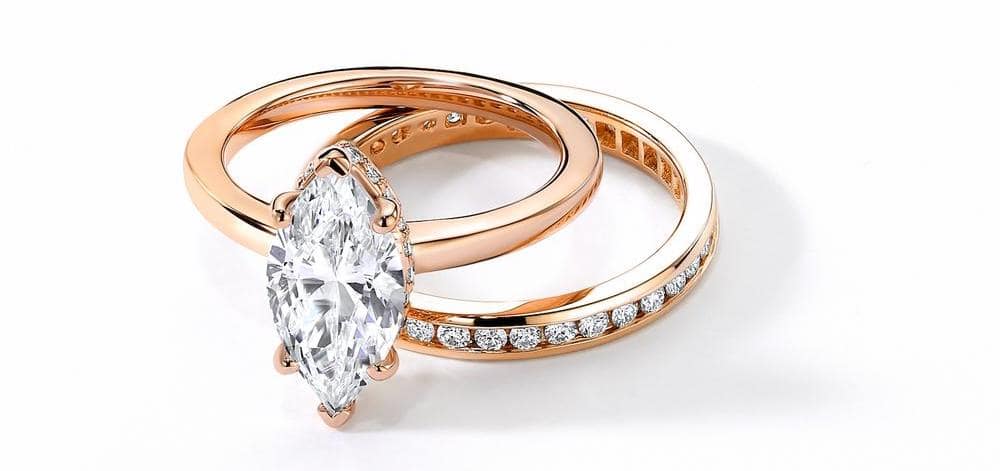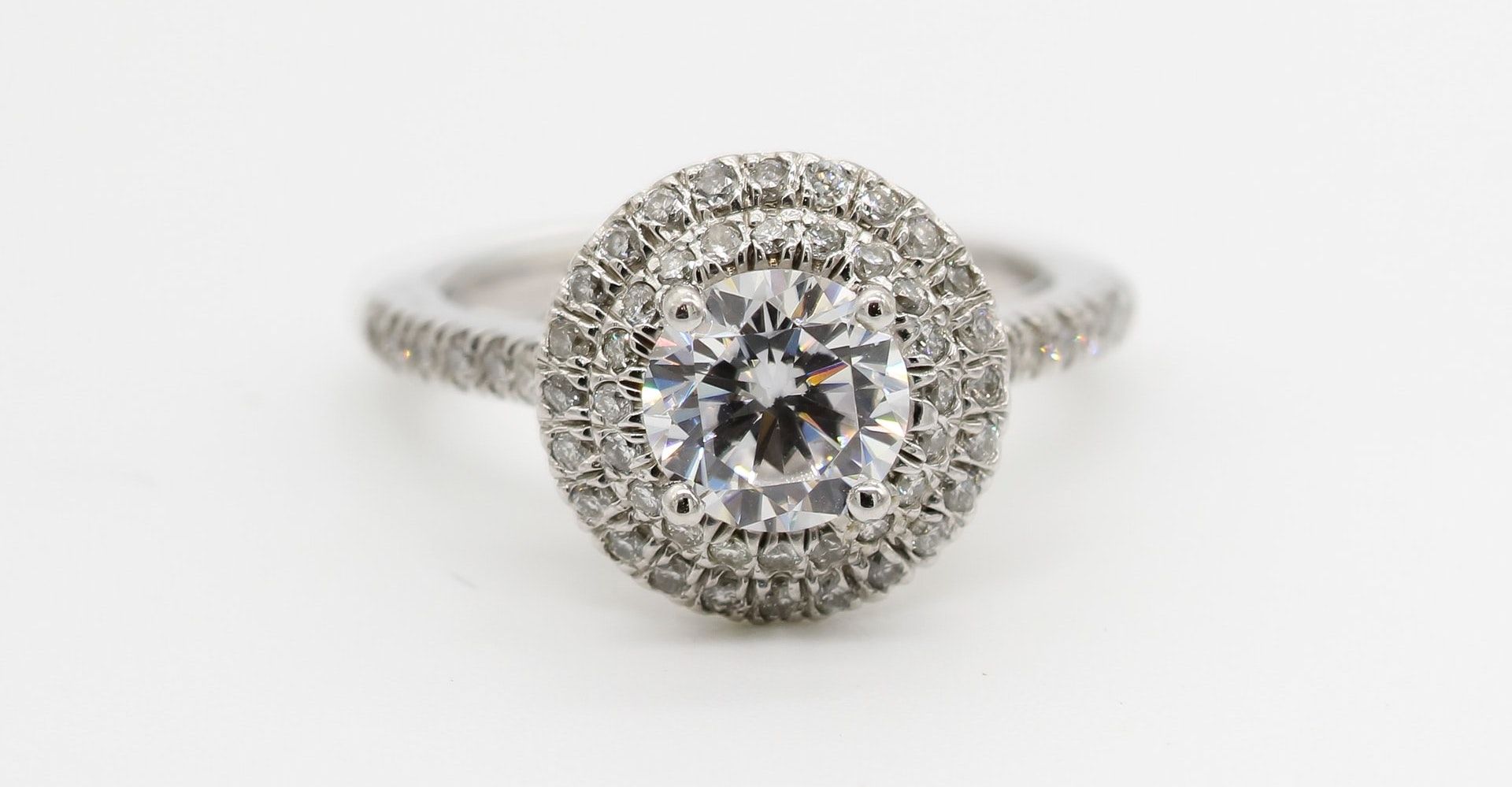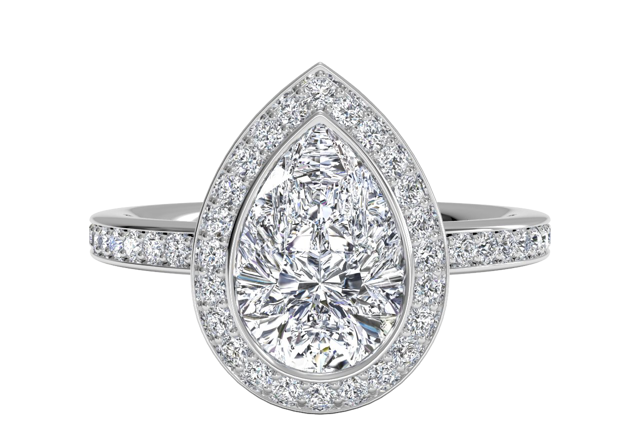How to Buy A Rose Gold Engagement Ring

So you’re looking to buy an engagement ring, and you’re considering rose gold. Well, you’re in the right place because rose gold is about as romantic as it gets.
These engagement rings are the epitome of romanticism, and if ever love were to be encapsulated in the form of a ring, it would be rose gold.
Over the years, rose gold has interchangeably been the centerpiece to some trends, while taking a backseat to others. Current popular uses of rose gold include the latest iPhone, laptops, and even cars. This trend seems to suggest that we’re in the midst of a rose gold revolution.
Rose gold, without question, is unique. But before we get any further, how is rose gold different, and what do you need to know about it before you make this crucially important decision?
History of Rose Gold
Rose gold came to prominence in 19th century Russia, when Carl Fabergé began using the beautiful metal in his famous jeweled eggs. In 1924, Cartier featured the metal in their iconic Trinity Band, which has since sealed its position as an elegant and timeless choice for fine jewelry.
Have you noticed lots of vintage rose gold engagement rings? That’s because, during World War II, platinum was restricted for use in the war, so jewelers turned to yellow and rose gold instead.
Rose gold owes part of its wide appeal to the fact that it complements virtually all skin tones. This universality has made rose gold a popular option cross-culturally for many years.
Click here to keep reading about the history of rose gold.
What Is Rose Gold?
Rose gold is an alloy that makes use of several metallic compounds to give it its rich appearance. It’s usually a mixture of gold and copper, as well as some silver or zinc.
Although the terms “red gold”, “rose gold”, and “pink gold” are often thought to be the same, they are actually different and copper content is one of the key distinguishing factors.
For jewelry, rose gold is typically sold in 14kt rose gold or 18kt rose gold. “Karat” is a measure of how much gold is used in the piece. 14kt rose gold contains 58% pure gold and 42% copper alloys; 18kt rose gold contains 75% pure gold and 25% copper alloys. At Ritani, we offer 18kt rose gold engagement rings for their beauty and higher gold content.
A good tip to remember is that as the percentage of copper content in a ring increases, so does its redness in most cases. So, if your goal is to find a rose gold ring that exudes a deep blush color, then you’ll want a lower karat rose gold ring. For example, 10kt rose gold will have a deeper red tone than 18kt rose gold.
Rose gold can be thought of as a midway point between red and pink gold, because the amount of copper within it (usually around 22% copper) tops that of pink gold (20% copper) but comes short of red gold (25% copper).
Is Rose Gold Durable?
Oddly enough, rose gold is just as durable, or even more so, than white or yellow gold because of its extra copper content. As a general rule, you’ll find that rose gold is less prone to damaging wear and tear than yellow gold. Platinum however, is stronger than all three.
Due to its inherent strength, rose gold doesn’t require an exterior layer of plating like white gold does. This also means that a rose gold ring will resist scratches and dents more than other metals.
Are Rose Gold Engagement Rings More Expensive?
You might think that rose gold would be more affordable than yellow or white gold because of the addition of copper which is generally a cheaper metal. However, you might be surprised to learn that yellow gold also contains copper. It’s just a matter of proportions of alloyed metals that determines the color.
While there are negligible price differences depending on the alloyed metals, the amount of gold in a wedding band is what is going to drive the price of a piece of jewelry. Since an 18kt rose gold ring has just as much gold as an 18kt yellow gold ring, it will generally be priced the same.
On the other hand, platinum or palladium jewelry will be priced higher because both of those metals are currently significantly more expensive than gold.
Does Rose Gold Tarnish?
Rose gold has the unique advantage of not tarnishing. In fact, like a bottle of wine, it actually gets better with time.
As time goes by, a sheen-like patina develops, resulting from oxidation. So, the longer your loved one wears the ring, the more the beautifully blush persona of rose gold enhances.
Is Rose Gold Hypoallergenic?
Because of the copper in rose gold, it is not hypoallergenic. Although copper tends to be the source of the majority of ring-related allergic reactions in people, other materials present in rose gold may also cause reactions.
Palladium, zinc, and silver may also be used in rose gold engagement rings, so it’s important to be aware of exactly which metals exist in the ring your loved one intends to wear. Ritani’s 18kt rose gold jewelry, which is composed of zinc, silver, and copper, (75% gold, 25% alloy) is a perfect example of the alloyed base of materials contained in many of these rings.
Additionally, lower karat rose gold rings, (such as 10kt) will contain higher amounts of non-gold materials. Ultimately, what rose gold loses in not being hypoallergenic, it makes up for in durability and its soft, blush appeal.
Is Rose Gold Too Trendy for an Engagement Ring?
As discussed earlier, rose gold is no new fad - it has endured the tests of time. Rose gold is here to stay and is a beautiful choice for your engagement ring. If you love it, why pass it up? You can always choose to reset your diamond in a white gold, yellow gold, or platinum setting in the future if you wish.
Cleaning Rose Gold
Keeping rose gold clean is essential to maintain the beauty of your ring. Over time, the metal can acquire a natural patina that may dull the look of your setting. Regular cleaning could serve the dual purpose of both preventing that and keeping your jewelry in good condition.
For cleaning tips and other ring care essentials read 9 Things You Should Be Doing To Care for Your Engagement Ring.
Finding The Right Setting
The setting is the piece of metal that secures your diamond to the band. The most popular settings are solitaire settings, sidestone settings, halo settings, three-stone settings, and vintage settings.
Solitaire Engagement Rings

Solitaire engagement rings feature a plain band that allows your choice of diamond to be the star of the show. Solitaire settings are a timeless choice for your engagement ring and are typically the most affordable option since they do not feature any diamond accents. Solitaires are one of the most popular choices for engagement rings.
Sidestone Engagement Rings

Sidestone engagement rings feature tiny diamonds in the band that provide extra sparkle and glamour to your ring. This timeless setting will highlight the brilliance and sparkle of any diamond you choose.
Halo Engagement Rings

Halo engagement rings are another popular style. Halo engagement rings feature tiny diamonds surrounding the center stone, which creates more sparkle and creates the illusion of a larger diamond.
Three Stone Engagement Rings

Three stone rings feature two diamonds that flank the center stone. It's said that the three stones in this classic ring represent your past, present, and future together as a couple.
Vintage Engagement Rings

Vintage engagement rings borrow beloved styles from the past, such as milgrain, diamond halos, and ornate designs. Vintage-inspired rings tend to be a little more pricey than other styles due to the extra diamonds and metal that go into making them.
Finding The Right Diamond
Finding the right diamond for your rose gold setting can be a bit tricky, but we’ll briefly break it down for you here. When it comes down to it, your diamond and setting should bring out the best in each other, and this ultimately comes down to a matter of contrast.
Diamond Shape
First, let’s start with what you may want to avoid. Generally speaking, this means avoiding pairing step cut diamonds with rose gold rings, unless you are okay with your diamond having a little warmth. Step-cut diamonds, which include emerald-cuts as well as Asschers, have large, open facets that don’t reflect light as well as brilliant-cut diamonds. This in turn reflects the metal’s color into the stone more powerfully, which can give a colorless diamond an unwanted rosy tone.
Classic round diamonds and pretty much any other fancy shape like the cushion, radiant, and oval, work well with rose gold. Each has tremendously reflective facets that sparkle and shine and offer a beautiful contrast when paired with your rose gold setting.
Color Grades
There’s definitely an art to finding the right diamond color grade that best complements a rose gold setting. On the diamond color scale, stones as low as H and I or J usually complement rose gold the best. These near-colorless diamonds are far more affordable than colorless diamonds and will still face up as white in your setting. You can even go as low as K or L colored diamonds, which will pair beautifully with the warmth of a rose gold setting.

Image source: Image source: gia.edu
Cut and Clarity
In general, cut and clarity grades will make the biggest impact on the beauty of your diamond regardless of metal. It’s best to choose the highest cut grade possible for your diamond as a diamond’s cut affects how much it will sparkle. For round-cut diamonds, that’s an Ideal cut, and for fancy shapes, that’s a Very Good cut.
Clarity refers to how many inclusions (internal flaws) and blemishes (external flaws) a diamond has. The best clarity grades a diamond can receive is a Flawless clarity grade (no inclusions or blemishes). Flawless diamonds are very rare, and therefore very expensive. At Ritani, the lowest clarity grade we offer is SI2 (Slightly Included 2). These diamonds have some small inclusions that may be visible to the naked eye.

Read more about cut and clarity grades here.
Ready to design your rose gold engagement ring?


